I have been posting daily water historical happenings since September 1, 2012 on my other blog This Day in Water History. I thought it would be fun to choose my favorites and post short versions of them for your perusal and amusement.
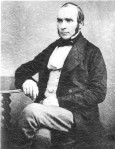 September 7, 1854: The St. James Board of Governors and Directors of the Poor was convinced by Dr. John Snow that the Broad Street pump was the source of a cholera epidemic in a London neighborhood. The Board ordered the removal of the pump handle preventing a continuation of the epidemic. Incredibly, public protests resulted in the replacement of the pump handle on September 26, 1855.
September 7, 1854: The St. James Board of Governors and Directors of the Poor was convinced by Dr. John Snow that the Broad Street pump was the source of a cholera epidemic in a London neighborhood. The Board ordered the removal of the pump handle preventing a continuation of the epidemic. Incredibly, public protests resulted in the replacement of the pump handle on September 26, 1855.
 September 26, 1908: First day of operation of the chlorination facility at Boonton Reservoir for Jersey City, NJ. This was the first continuous use of chlorine in the U.S. for drinking water disinfection. Dr. John L. Leal was responsible for this breakthrough in public health. Details of the facility planning and operation are included in The Chlorine Revolution: Water Disinfection and the Fight to Save Lives.
September 26, 1908: First day of operation of the chlorination facility at Boonton Reservoir for Jersey City, NJ. This was the first continuous use of chlorine in the U.S. for drinking water disinfection. Dr. John L. Leal was responsible for this breakthrough in public health. Details of the facility planning and operation are included in The Chlorine Revolution: Water Disinfection and the Fight to Save Lives.
 September 30, 1936: Hoover Dam Dedication by U.S. Secretary of the Interior, Harold L. Ickes and President Franklin D. Roosevelt. Click HERE for an audio recording of the dedication. New York Times headline–President…Speaks at Boulder Dam. ”Standing on a platform perched high above the Colorado River at the eastern terminus of the great, towering Boulder Canyon Dam, President Roosevelt dedicated it today…
September 30, 1936: Hoover Dam Dedication by U.S. Secretary of the Interior, Harold L. Ickes and President Franklin D. Roosevelt. Click HERE for an audio recording of the dedication. New York Times headline–President…Speaks at Boulder Dam. ”Standing on a platform perched high above the Colorado River at the eastern terminus of the great, towering Boulder Canyon Dam, President Roosevelt dedicated it today…
 October 14, 1862: New York Times headline–Mixing of Water with Milk Not an Adulteration. “The People ex rel. Jacob Fauerbach vs. Court of Sessions. — The relator was convicted in the Court of Sessions of vending adulterated milk, and sentenced to pay a fine of $55. He appealed the case to the New York Supreme Court, contending that the act under which he was convicted was purely a sanitary measure, intending to prevent traffic in impure, diseased and unwholesome milk…
October 14, 1862: New York Times headline–Mixing of Water with Milk Not an Adulteration. “The People ex rel. Jacob Fauerbach vs. Court of Sessions. — The relator was convicted in the Court of Sessions of vending adulterated milk, and sentenced to pay a fine of $55. He appealed the case to the New York Supreme Court, contending that the act under which he was convicted was purely a sanitary measure, intending to prevent traffic in impure, diseased and unwholesome milk…
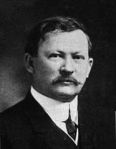 October 21, 1914: The first numerical drinking water regulations in the U.S. were adopted. “On October 21, 1914, pursuant to the recommendation of the Surgeon General of the Public Health Service [Dr. Rupert Blue], the Treasury Department adopted the first standards for drinking water supplied to the public by any common carrier engaged in interstate commerce. These standards specified the maximum permissible limits of bacteriological impurity…
October 21, 1914: The first numerical drinking water regulations in the U.S. were adopted. “On October 21, 1914, pursuant to the recommendation of the Surgeon General of the Public Health Service [Dr. Rupert Blue], the Treasury Department adopted the first standards for drinking water supplied to the public by any common carrier engaged in interstate commerce. These standards specified the maximum permissible limits of bacteriological impurity…
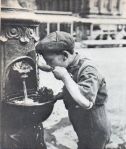 October 30, 1912. 100th Anniversary of the Regulation Banning the Common Cup. At the turn of the 20th century, public health professionals were still struggling to incorporate the precepts of the germ theory into all of their protocols. The general population was even further behind and, in many cases, resisted the momentum for change. One popular custom during this period was the use of a single cup or dipper for a pail of water or water cooler aboard trains—the common cup. Disease transmission as a result of using a common cup in public places was a serious problem…
October 30, 1912. 100th Anniversary of the Regulation Banning the Common Cup. At the turn of the 20th century, public health professionals were still struggling to incorporate the precepts of the germ theory into all of their protocols. The general population was even further behind and, in many cases, resisted the momentum for change. One popular custom during this period was the use of a single cup or dipper for a pail of water or water cooler aboard trains—the common cup. Disease transmission as a result of using a common cup in public places was a serious problem…
 November 16, 1918: Municipal Journal. A Sanitary Survey of an Unnamed City. The conditions about which you will read were by no means unusual in 1918 in the U.S. “A State Board of Health a few months ago, made a sanitary survey of a certain city (the name of which is unessential) which was of more than usual interest, because of its thoroughness and the sensible recommendations based upon it….The city in question has a population of about 30,000
November 16, 1918: Municipal Journal. A Sanitary Survey of an Unnamed City. The conditions about which you will read were by no means unusual in 1918 in the U.S. “A State Board of Health a few months ago, made a sanitary survey of a certain city (the name of which is unessential) which was of more than usual interest, because of its thoroughness and the sensible recommendations based upon it….The city in question has a population of about 30,000
 November 25, 1988: New York Times headline—Britain Planning to Sell Its Waterworks. “The British Government today began the latest and most contentious step in its sweeping privatization program by presenting its plans for selling off the nation’s state-owned water industry. ‘Privatizing water makes about as much sense as privatizing the air we breathe.’…
November 25, 1988: New York Times headline—Britain Planning to Sell Its Waterworks. “The British Government today began the latest and most contentious step in its sweeping privatization program by presenting its plans for selling off the nation’s state-owned water industry. ‘Privatizing water makes about as much sense as privatizing the air we breathe.’…
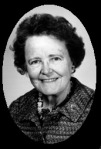 November 26, 1907: 105th Birthday of Dr. Ruth Patrick. “Dr. Ruth Myrtle Patrick (born November 26, 1907) is a botanist and limnologist specializing in diatoms and freshwater ecology, who developed ways to measure the health of freshwater ecosystems and established a number of research facilities. Dr. Patrick’s research in fossilized diatoms showed that the Great Dismal Swamp between Virginia and North Carolina was once a forest, which had been flooded by seawater. Similar research proved that the Great Salt Lake was not always a saline lake.
November 26, 1907: 105th Birthday of Dr. Ruth Patrick. “Dr. Ruth Myrtle Patrick (born November 26, 1907) is a botanist and limnologist specializing in diatoms and freshwater ecology, who developed ways to measure the health of freshwater ecosystems and established a number of research facilities. Dr. Patrick’s research in fossilized diatoms showed that the Great Dismal Swamp between Virginia and North Carolina was once a forest, which had been flooded by seawater. Similar research proved that the Great Salt Lake was not always a saline lake.
 December 3, 1842: Ellen Swallow Richards was born. “Ellen Swallow Richards is perhaps best known as MIT’s first female graduate and instructor, but launching coeducation at the Institute is merely the first in a long list of her pioneering feats. The breadth and depth of her career are astounding; a 1910 tribute in La Follette’s Weekly Magazine professed that ‘when one attempts to tell of the enterprises, apart from her formal teaching, of which Mrs. Richards has been a part or the whole, he is lost in a bewildering maze.’ Authors and scholars have called her the founder of ecology, the first female environmental engineer, and the founder of home economics.
December 3, 1842: Ellen Swallow Richards was born. “Ellen Swallow Richards is perhaps best known as MIT’s first female graduate and instructor, but launching coeducation at the Institute is merely the first in a long list of her pioneering feats. The breadth and depth of her career are astounding; a 1910 tribute in La Follette’s Weekly Magazine professed that ‘when one attempts to tell of the enterprises, apart from her formal teaching, of which Mrs. Richards has been a part or the whole, he is lost in a bewildering maze.’ Authors and scholars have called her the founder of ecology, the first female environmental engineer, and the founder of home economics.
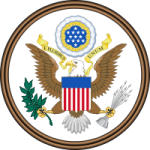 December 16, 1974: Safe Drinking Water Act signed into law by President Ford. “The Safe Drinking Water Act (SDWA) is the principal federal law in the United States intended to ensure safe drinking water for the public. Pursuant to the act, the Environmental Protection Agency (EPA) is required to set standards for drinking water quality and oversee all states, localities, and water suppliers who implement these standards.
December 16, 1974: Safe Drinking Water Act signed into law by President Ford. “The Safe Drinking Water Act (SDWA) is the principal federal law in the United States intended to ensure safe drinking water for the public. Pursuant to the act, the Environmental Protection Agency (EPA) is required to set standards for drinking water quality and oversee all states, localities, and water suppliers who implement these standards.
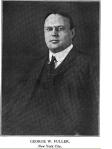 December 21, 1868: George Warren Fuller is born in Franklin, Massachusetts. George Warren Fuller was, quite simply, the greatest sanitary engineer of his time, and his time was long—lasting from 1895 to 1934. In truth, we have not seen his like since. How did he reach the pinnacle of his field? What early influences led him on his path? There is a biography of Fuller on Wikipedia that I wrote which summarizes his life from a “neutral point of view.” The material below is taken in part from Chapter 7 of The Chlorine Revolution: Water Disinfection and the Fight To Save Lives. By design, it gives more of a personal flavor to his life.
December 21, 1868: George Warren Fuller is born in Franklin, Massachusetts. George Warren Fuller was, quite simply, the greatest sanitary engineer of his time, and his time was long—lasting from 1895 to 1934. In truth, we have not seen his like since. How did he reach the pinnacle of his field? What early influences led him on his path? There is a biography of Fuller on Wikipedia that I wrote which summarizes his life from a “neutral point of view.” The material below is taken in part from Chapter 7 of The Chlorine Revolution: Water Disinfection and the Fight To Save Lives. By design, it gives more of a personal flavor to his life.




Thanks Mike,
A few other tidbits:
According to Steven Johnson’s book, The Ghost Map, John Snow was quite a guy. He was a pioneer in the use of inhaled anesthetics like chloroform and ether, and he tested them on himself, probably leading to his premature death. He used chloroform to help Queen Victoria with delivery of one of her children, and she loved it.
Another bit re the 1946 USPS drinking water standards. They included chromium at 50 ppb and stated that it assumed all chromium +6, as did the later SDWA regulations, contrary to some assertions from our CA friends at OEHHA. So, indeed Cr VI has been regulated for at least 66 years. They got it right back then!! Wasting a lot of time and money now.
Joe Cotruvo
n 1/1/2013 2:57 AM, safedrinkingwaterdotcom wrote: > WordPress.com > safedrinkingwaterdotcom posted: “I have been posting daily water > historical happenings since September 1, 2012 on my other blog This > Day in Water History. I thought it would be fun to choose my favorites > and post short versions of them for your perusal and amusement. > September 7, 1854” >
Mike,
Thanks for the quick trip through water history. It’s quite fascinating and shows how far we’ve come in such a relatively short time. Thanks for your hard work with this blog and discussion group.
Joe–Thanks for your comments. I agree completely with you about the Cr6 regulation. They got it right.
John–Thank you for your comment. I has been fun putting this together.